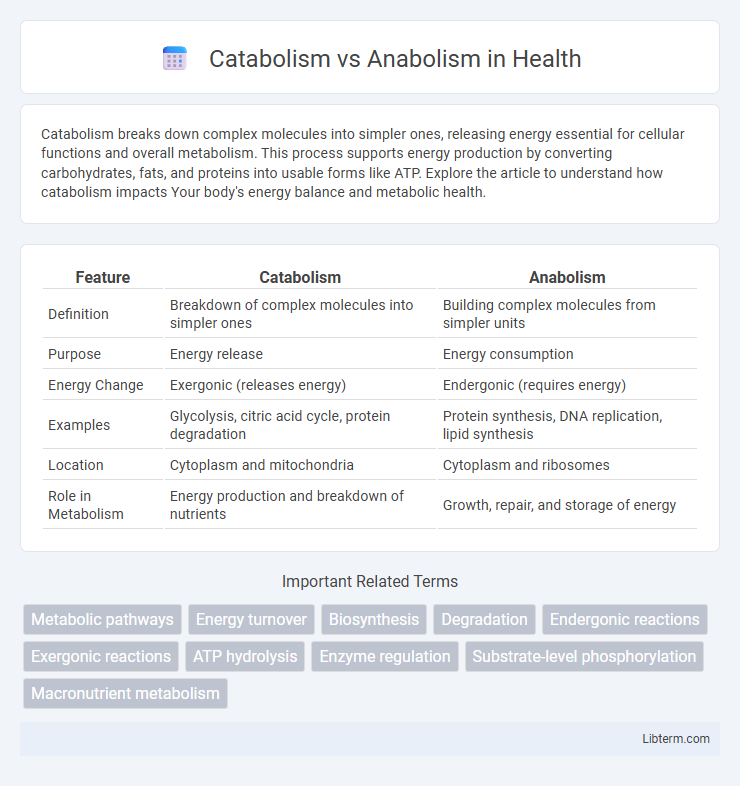Catabolism breaks down complex molecules into simpler ones, releasing energy essential for cellular functions and overall metabolism. This process supports energy production by converting carbohydrates, fats, and proteins into usable forms like ATP. Explore the article to understand how catabolism impacts Your body's energy balance and metabolic health.
Table of Comparison
| Feature | Catabolism | Anabolism |
|---|---|---|
| Definition | Breakdown of complex molecules into simpler ones | Building complex molecules from simpler units |
| Purpose | Energy release | Energy consumption |
| Energy Change | Exergonic (releases energy) | Endergonic (requires energy) |
| Examples | Glycolysis, citric acid cycle, protein degradation | Protein synthesis, DNA replication, lipid synthesis |
| Location | Cytoplasm and mitochondria | Cytoplasm and ribosomes |
| Role in Metabolism | Energy production and breakdown of nutrients | Growth, repair, and storage of energy |
Introduction to Catabolism and Anabolism
Catabolism involves the breakdown of complex molecules into simpler units, releasing energy essential for cellular activities. Anabolism, by contrast, utilizes this energy to synthesize complex molecules from simpler ones, supporting growth and repair. These metabolic pathways work together to maintain the body's energy balance and facilitate vital biochemical processes.
Defining Catabolism: The Breakdown Processes
Catabolism is the metabolic pathway that breaks down complex molecules such as carbohydrates, lipids, and proteins into simpler units, releasing energy stored in chemical bonds. This process produces adenosine triphosphate (ATP), which cells use to fuel various biological activities. Key catabolic reactions include glycolysis, the citric acid cycle, and oxidative phosphorylation, all essential for maintaining cellular energy balance.
What is Anabolism? Building Blocks Explained
Anabolism is the metabolic process that constructs complex molecules from simpler building blocks, such as amino acids forming proteins or nucleotides forming DNA. This energy-consuming phase supports cell growth, repair, and maintenance by synthesizing essential macromolecules required for life functions. Key anabolic pathways include protein synthesis, lipid formation, and nucleic acid assembly, which are vital for maintaining cellular structure and function.
Key Differences: Catabolism vs Anabolism
Catabolism involves the breakdown of complex molecules into simpler ones, releasing energy stored in chemical bonds, while anabolism uses energy to synthesize complex molecules from simpler precursors. Catabolic pathways include glycolysis and the citric acid cycle, which generate ATP, whereas anabolic pathways encompass protein synthesis and lipid formation, requiring ATP input. The key difference lies in their energy flow: catabolism is exergonic and energy-releasing, whereas anabolism is endergonic and energy-consuming.
Role of Enzymes in Metabolic Pathways
Enzymes play a crucial role in metabolic pathways by catalyzing specific reactions in both catabolism and anabolism, ensuring efficient energy transfer and molecular synthesis. In catabolic pathways, enzymes break down complex molecules into simpler ones, releasing energy stored in chemical bonds often captured in ATP. In anabolic processes, enzymes facilitate the construction of complex molecules from simpler precursors, utilizing the energy derived from catabolism to build essential cellular components such as proteins, lipids, and nucleic acids.
Energy Production and Consumption
Catabolism involves the breakdown of complex molecules like carbohydrates, lipids, and proteins into simpler molecules, releasing energy stored in chemical bonds, primarily in the form of ATP. Anabolism consumes this energy to synthesize complex macromolecules such as proteins, nucleic acids, and lipids necessary for cellular growth and repair. The balance between catabolic energy production and anabolic energy consumption is crucial for maintaining metabolic homeostasis and supporting vital biological functions.
Examples of Catabolic Reactions
Catabolic reactions break down complex molecules into simpler ones, releasing energy essential for cellular activities. Examples include glycolysis, where glucose is degraded into pyruvate, and the Krebs cycle, which further oxidizes acetyl-CoA to produce ATP, NADH, and FADH2. Lipid catabolism involves the beta-oxidation of fatty acids into acetyl-CoA, fueling the energy production pathways.
Examples of Anabolic Reactions
Anabolic reactions involve the synthesis of complex molecules from simpler ones, such as the formation of proteins from amino acids, the creation of glycogen from glucose, and the production of fatty acids from acetyl-CoA. These processes require energy input, typically in the form of ATP, reflecting their role in growth, repair, and storage within cells. Key examples of anabolic pathways include protein synthesis during muscle repair, glycogenesis in liver cells, and lipogenesis in adipose tissue.
Importance in Human Health and Fitness
Catabolism breaks down complex molecules into simpler ones, releasing energy essential for bodily functions and physical activity, while anabolism uses that energy to build and repair tissues, supporting muscle growth and recovery. Maintaining a balance between catabolic and anabolic processes is crucial for metabolic health, muscle maintenance, and overall fitness progression. Disruptions in this balance can lead to muscle wasting or excessive fat accumulation, impacting physical performance and health outcomes.
Balancing Catabolic and Anabolic States
Balancing catabolic and anabolic states is essential for maintaining metabolic homeostasis and overall health. Catabolism breaks down molecules to release energy, while anabolism synthesizes complex molecules, requiring energy input. Optimizing nutrient intake, physical activity, and hormonal regulation ensures equilibrium between these processes, supporting muscle growth, tissue repair, and efficient energy utilization.
Catabolism Infographic

 libterm.com
libterm.com